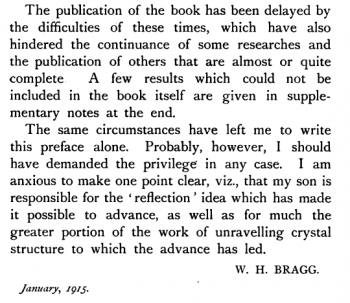The preface to X-Rays and Crystal Structure does all the usual things you’d expect in a scientific text—explains a general hypothesis, describes some challenges, gives thanks to contributors in the field. The few pages, however, only hint at some of the unique circumstances about the landmark text and the people behind it—a tricycle accident, a war, and a “little book” that earned a father and son a Nobel Prize, 100 years ago.
The writer behind the book’s introduction, William Henry Bragg, notes that his eldest son, William Lawrence, is responsible for the core idea of the text—now known as Bragg’s Law of X-ray crystallography, used widely in the scientific community. The father-son duo’s history with the X-ray itself unceremoniously began with William Lawrence, too. In 1895, a then five year-old W.L. fell off his trike and fractured his elbow. At the time, X-rays were in their experimental phase (the developer of the X-ray, Wilhelm Conrad Rontgen, would earn a Nobel Prize for it in 1901). W.H. Bragg, a professor of math and physics at the University of Adelaide, had been conducting his own X-ray experiments. Bragg used his equipment to scan his son’s broken arm, the first X-ray images captured in Australia.
![William Lawrence Bragg (1890-1971), Smithsonian Institution Archives, SIA Acc. 90-105 [SIA2007-0339]. William Lawrence Bragg (1890-1971)](https://ids.si.edu/ids/iiif/SIA-SIA2007-0339/full/200,/0/default.jpg)
The Braggs’ own X-ray discovery occurred several years later, and began as few other remarkable ideas do—on summer vacation. W.L. was home for summer break from Trinity College, where he was studying physics. During the summer of 1912, W.H. told his son about a recent book by
Max von Laue, a German scientist who believed that X-rays could be diffracted through crystals. The young man went back to school inspired to experiment on his own. Back at home, W.H. was at work developing an X-ray spectrometer, to measure wavelengths of the X-ray. When his son came home on school breaks, they combined their research. A new theory emerged, blooming despite what the older Bragg came to describe in their book as “the difficulties of these times,” which set back more than just scientific research—World War I.
When WWI broke out in July 1914, the younger Bragg had just begun a Fellowship at Trinity. That was quickly sidelined, and he was stationed at the British army headquarters in France, working as a technical adviser on sound-ranging methods to locate enemy gunfire. His father supported the war effort, too, advising on submarine detection, as well as continued work on what would become X-Rays and Crystal Structure. In the introduction, W.H. Bragg is quick to note that his son was not there to contribute to the preface (for which he notes, as the elder of the duo, he “should have demanded the privilege in any case.”), taken away from his research by wartime necessity.

William Lawrence Bragg’s work during the war earned him a Military Cross. His work on the X-ray earned him and his father a joint Nobel Prize in Physics, which he was awarded while still in France with the British army, at just 25 years-old. The win was bittersweet for the father-son pair, however. The Braggs’ younger son, Robert, was killed in the Battle of Gallipoli in Turkey during September of 1915. Bob and his brother were less than three years apart in age—with his older brother recalling in his autobiography their years sharing both a pram and the embarrassment of being pushed in one—and the loss was tough. Just two months later, Bragg received a telegram with news that he and his father had won the Nobel Prize. The Braggs remain the only father-son Nobel Laureates.
![William Lawrence Bragg and William Henry Bragg. Smithsonian Institution Archives, SIA Acc. 90-105 [SIA2007-0340]. William Lawrence Bragg and William Henry Bragg. Smithsonian Institution Archives, SIA Acc. 90-105 [S](https://siarchives.si.edu/sites/default/files/styles/body-image-350h/public/blog-attached-images/SIA2007-0340.jpg?itok=TeMciaz3)
![(left to right) Robert Williams Wood (1868-1955), William Henry Bragg (1862-1942) and Charles Greeley Abbot (1872-1973), 1939, Smithsonian Institution Archives, SIA Acc. 90-105 [SIA2007-0343]. (left to right) Robert Williams Wood (1868-1955), William Henry Bragg (1862-1942) and Charles Greele](https://ids.si.edu/ids/iiif/SIA-SIA2007-0343/full/300,/0/default.jpg)
Post World War I, both men returned to academia. W.H. Bragg began a professorship at University College London after the war, and from 1923 worked as a professor of chemistry and a laboratory director at the Royal Institution of Great Britain. His son returned from France to begin work as a physics professor at the University of Manchester, and jobs at the National Physical Laboratory and Cambridge followed. By 1954, he had followed in his father’s footsteps, becoming the Royal Institution director. For their many years of scientific contributions, both men were knighted. The younger Bragg (and the work he conducted with his father on the X-ray) also helped support the research of another set of Nobel Prize winners,
Francis Crick and James D. Watson who discovered the structure of DNA.
Related Resources
X-rays and Crystal Structure, by W. H. Bragg and W. L. Bragg, 1915
Publicity, Politics, and Physics, The Bigger Picture Blog, Smithsonian Institution Archives
Re-Prized, The Bigger Picture Blog, Smithsonian Institution Archives
Related Collections
Accession 90-105, Science Service Records, 1920s-1970s
![William Henry Bragg (1862-1942), Smithsonian Institution Archives, SIA Acc. 90-105 [SIA2007-0341]. William Henry Bragg (1862-1942), Smithsonian Institution Archives, SIA Acc. 90-105 [SIA2007-0341].](https://ids.si.edu/ids/iiif/SIA-SIA2007-0341/full/200,/0/default.jpg)
![William Lawrence Bragg (1890-1971), Smithsonian Institution Archives, SIA Acc. 90-105 [SIA2007-0339]. William Lawrence Bragg (1890-1971)](https://ids.si.edu/ids/iiif/SIA-SIA2007-0339/full/200,/0/default.jpg)
![(left to right) Robert Williams Wood (1868-1955), William Henry Bragg (1862-1942) and Charles Greeley Abbot (1872-1973), 1939, Smithsonian Institution Archives, SIA Acc. 90-105 [SIA2007-0343]. (left to right) Robert Williams Wood (1868-1955), William Henry Bragg (1862-1942) and Charles Greele](https://ids.si.edu/ids/iiif/SIA-SIA2007-0343/full/300,/0/default.jpg)

![William Lawrence Bragg and William Henry Bragg. Smithsonian Institution Archives, SIA Acc. 90-105 [SIA2007-0340]. William Lawrence Bragg and William Henry Bragg. Smithsonian Institution Archives, SIA Acc. 90-105 [S](https://siarchives.si.edu/sites/default/files/styles/body-image-350h/public/blog-attached-images/SIA2007-0340.jpg?itok=TeMciaz3)
Leave a Comment